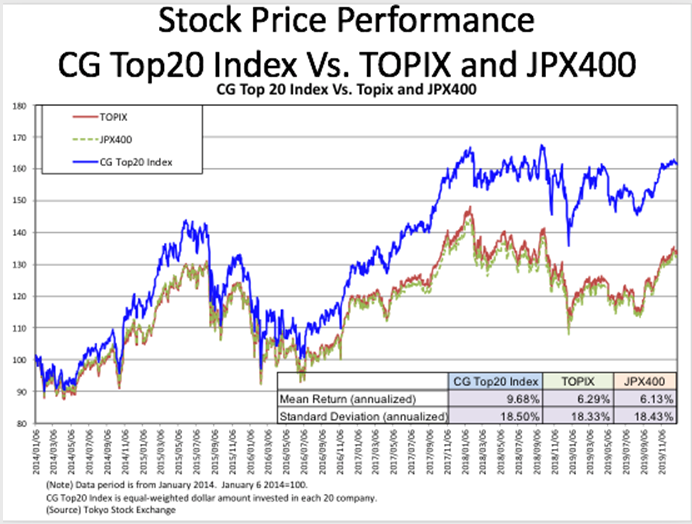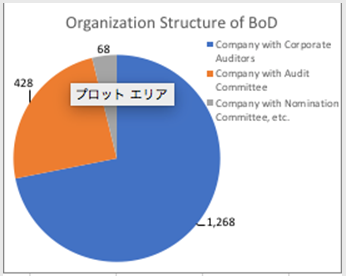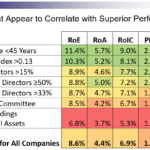
Stock prices edged slightly higher amid low trading volume from the previous month. TOPIX and JPX400 market indices gained 0.06% and 0.06% respectively for the month. CG Top 20 stocks kept solid up by 0.02% for the same period.

Make a new forum entry

Stock prices edged slightly higher amid low trading volume from the previous month. TOPIX and JPX400 market indices gained 0.06% and 0.06% respectively for the month. CG Top 20 stocks kept solid up by 0.02% for the same period.


Public companies in Japan employ three types of legal governance structures for their boards. The three types of organizational structure are the Company with Corporate Auditors, the Company with an Audit Committee and the Company with Nomination Committee, etc. However, as shown in the pie chart below, very few companies use the Nomination Committee format. The number of companies shown below is based on Metrical’s research universe of 1,754 companies but the number of Companies with Nomination Committee, etc. would not be much different even if more smaller companies were included.


On December 11, 2019, Nicholas Benes gave a lecture on Corporate Governance Practices and Firm Performance in Japan at the Securities Analysts Association of Japan. It was generally well-received and covered the following topics:
Of note were the three main themes that were discussed: (1) There are visible relationships between certain corporate governance practices and financial performance (2) the direction of causation is most important to confirm, and so far, BDTI’s analysis suggests that a number of specific governance practices actually do seem to “cause” improvement rather than simply serve as evidence that management wants to “look good”; and (3) this information is vitally useful for analysts and investors alike, in order to improve the effectiveness of investor engagement that enhances profitability, growth and stock performance in a win-win cycle.
1) Pension Funds
2) Other Types of Investors
3) “ESG Factors”
4) Debt Instruments
1) Pension Funds
The proposed revisions to the Stewardship Code do not make it clear enough exactly how corporate pension funds, or smaller pension funds of any type, can sign the Code and comply with it without bearing excessive cost, work, or confusion. Because this is not sufficiently clear at present, to date only an extremely small number of the defined-benefit pension funds at listed non-financial companies in Japan have signed the Code (only about 10, out of a total of 700 or more such funds). As a result, a rather odd situation exists in that most Japanese companies claim to care for their employees deeply, but judging from their actions, do not seem to care much about employees’ investments or post-retirement quality of life – or even, to care about preserving shareholder value by reducing the cash infusions needed to keep their pension plan fully funded. This makes a mockery of the language in the Corporate Governance Code about stewardship (Principle 2.6 企業年金のアセットオーナーとしての機能発揮), and of the Stewardship Code itself.

Almost 70% of respondents do not agree with the amendment and 86% showed their concern that the amendment might give a negative impact on the investment into the Japanese equity market.
It’s well known in Japan that entry to good universities is fiercely competitive, and then students mess around for four years, sleeping in lectures, putting more effort into club activities than study. As a consequence, the large employers who recruit hundreds of graduates every year mainly assess applicants on character and potential, and treat new hires as “trainees” to be developed, rather than contributors.
Shigenobu Nagamori, the founder of Nidec is interviewed in the Nikkei Business series on how to “wake up Japan” about his latest acquisition – not a company this time, but a university – Kyoto Gakuen. He feels that Japan has become too brand name obsessed about higher education and that 18 year olds should not have their future decided simply on the basis of their standardised score for the university entry exams.
In the Nikkei Business series on how to “wake up Japan”, Senior Chairman and former CEO of Japanese leasing and financial services company Orix Yoshihiko Miyauchi sees three mistakes that have led to Japan’s “lost three decades”:
As a result, Japanese companies were “like tiny boats on a big ocean,
using all their energy to avoid large waves. Rather than innovate or
grow, they focused on cost cutting”, says Miyauchi.
A screencast of Pernille Rudlin’s keynote speech on the challenges facing Japanese companies in Europe – given at the Dutch Embassy/JETRO Japan business event in London in September 2019 – can be found here in English and here in Japanese on Screencast.com
The 1990s were called the Lost Decade in Japan, and then as the economy seemed to stagnate in the 2000s, it became the Lost Two Decades. Now the Nikkei Business in a recent special series seems to be saying it has been a lost three decades. Turnover and profitability were growing through to around 1990 […]